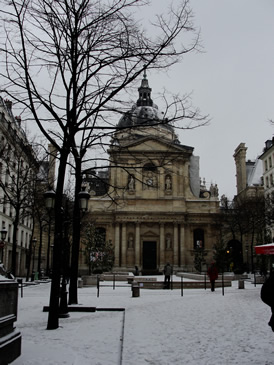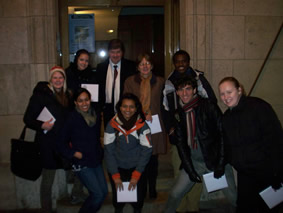Montparnasse


On our first full day in Paris, we headed out to Montparnasse, the part of town that was used by the famous Parisian artists of the early 20th century. These artists came from all over the world and included Pablo Picasso, Jean Cocteau, Tsuguharu Foujita and Edgar Degas, just to name a few. The architecture in Montparnasse is indicative of the artistic history: most buildings have large windows that let light into the in-house studios used by the artists. I spotted a Chinese restaurant called “Gastronomie Chinoise”, and for some reason, I found the name strange, worth mentioning. I was particularly impressed by the Japanese immigrant artist, Foujita. I quizzed Vincent our guide and learned that Foujita met and married a French lady in a rather impressive period of time (around 10 days)...so I was right to speculate that there was something “special” about the guy.
-Beneah
Les Halles
The neighborhood of Les Halles has long been a space of trade, a tradition which continues to this day through the large underground shopping mall the Forum des Halles. The area has undergone a series of renovations starting with the work done under Haussmann in the 19th century. Interestingly, a plaza near the Forum des Halles was built over the former Cemetery of Innocents, where citizens of lower classes were buried without distinction until the end of the 17th century. When the cemetery was filled to capacity and became a health hazard for habitants, it was emptied. The bodies were transferred to what are now known as the Catacombs.
-Monica
Belleville

What can someone do with a free morning in Paris? So much! A few of us took advantage of the free time and scoped out some of the quarters not mentioned on our schedule. We stopped by a neighborhood called Belleville. What describes Belleville? Immigration, noise, commotion, even dirtiness--not the typical “belle.” We witnessed a Belleville in movement: buying a croissant from a boulangerie, only to be overcharged (only by 10 centimes), seeing the woman behind the counter aggravated, obviously because of the busy morning, tasting the buttery croissant while watching two straight lines of children holding hands being led by their teacher around town, listening to kids making so much noise, pointing, joking—being kids. We walked up the hill of Belleville, and at the top, we reached a viewing point of the city. Did we look down? Not so much, more like looked straight. While the previous day, we were at the Montparnasse Tower and we could see cars moving up and down the long roads, at this height in Belleville, all we could see were stagnant buildings—no movement. I guess the “bouge-ing” really depends on one’s height or point of view.
-Vasudha
Quartier Latin

Warm and fed after a delicious lunch at Le Montebello, we headed off to explore the Quartier Latin. Sophie explained to us the how the original Université de Paris was founded by a ‘Corporation des Maîtres et Elèves’ in the 11th century, for “l’enseignement libre”, or free education. Apparently in order to be a professor, one had to demonstrate the “faculté d’enseigner”, the faculty or ability to teach theology, medicine, etc. The word “faculté” then came to refer to the different disciplines (Faculté des Arts, Faculté de Medicine etc), and nowadays we continue to see its use in the collegiate environment when we refer to professors as “faculty”.
Later, we visited the College de Bernadins, a place where monks used to be educated, which boasted the spectacular Salle de Refectoire. Compared to the rich colors and almost opulence of Sainte-Chapelle, the architecture here lacked ornamentation, which we learned was the Cistercienne’s philosophy in designing environments to encourage people to ‘return to prayer’.
We then walked by the Panthéon, where some of France’s most celebrated figures are interred, and then we saw Eglise St. Genevieve, high schools like Lycée Henry IV, and the former site of Ecole Polytechnique, which now is the Ministère d’Agriculture. While Sophie was pointing out the building to us, a security guard on walkie talkie came over to investigate what was going on, because he thought we were potentially starting a “manifestation” (demonstration)! As he got closer and heard Sophie, he responded back on the walkie talkie that it was “seulement une maitresse avec ses élèves”, or “only a school teacher with her pupils”. Très rigolo!
We eventually reached La Sorbonne, the prestigious and renowned Université de Paris, and Prof. Levet’s alma mater! 

Sophie managed to arrange a ‘visite guidée’ with Monsieur Serge Peyre. He explained how the university was founded by Robert de Sorbon, the private chaplain to Louis IX, who wanted to create a college with free instruction (even today it remains around 400 Euros per year). One of its benefactors later on was Cardinal Richelieu (yes- that Richelieu, the villain so well known in Dumas’s Three Musketeers) who also served as it’s Proviseur, or Principal, for some time.
Vasudha had the honor of opening the main door to the Grand Amphitheatre in the Palais Academique de la Sorbonne, apparently an honorific tradition for visiting guests. We sat inside the Amphitheatre surrounded by seated statues of influential intellectual figures such as Lavoisier and Descartes. M. Peyre explained how the statues were originally conceived to be in standing positions but eventually sculpted in seated positions so that students who would feel like they were “sitting next to greatness” (and hopefully encouraged and inspired by it) when they attended lecture. 


The spirit exhuded in this rich environment is the search for "la connaissance et le savoir" or knowledge, which drove the founding of this Quartier as a center for education hundreds of years ago. While populations, curricula and social paradigms may have changed over the centuries, this same journey lives on in the multitude of students who pass through the classrooms, libraries, cafés and bookstores today. Whether it is stimulating intellectual growth and the transition from youth to young adult, or social movement in the lively streets of this area, the Quartier Latin truly is a "quartier qui bouge".
-Samiksha
Le Marais
We explored places in Le Marais such as La Place des Vosges, local “Hôtel Particuliers,” and the Paris Historical Society. La Place des Vosges was a royal park that got its name from a mountainous town in France. They were the first town to pay their taxes after the French revolution in 1789. It was pretty and was surrounded by the apartments of the king’s court. All of the apartments were exactly the same height and looked the same except for two opposing apartments, which were named after the king and queen, even though they didn’t actually stay there. Under these apartments were passages cloaked with arches where there were stores (and even a guy playing the accordion the day we went). Next we went to the Hôtel Beauvais, a hôtel particulier. A hôtel particulier was a name for a special type of big house that was free-standing rather than connected on either side to other buildings (like most Parisian apartment buildings). This one is famous for having hosted many very famous people including Mozart. Lastly, we saw a Parisian Historical Society that had taken residence in an authentic medieval Paris building (most of which were destroyed under Baron Haussmann and Napoleon III in the mid-1800s). It had a cavernous basement where they did restoration as well as extremely windy stairs through the heart of the building to get to an open-air part. which was kind of like a porch surrounded on all four sides by the building.
-Amanda
12th & 13th

From country to city. This newer version of Paris seems quite rectangular; it minimizes the fanciness and intricate display—simplicity increased with time. While this construction is in Paris, the architects and designers are from all over the world, from Japan to Greece. We walked to the newer constructions of urban development in Paris. These buildings are amazing! And they are each unique and different from one another, yet are kept together, coexisting in the same area. Each apartment building has its own style, color, shape and design. While I feel that this sense of individual and unity is novel and innovative, I wonder if it is too much all in one place. Afterward, we had lunch in the "countryside of France" (a restaurant designed as such). Paris in movement. Having this available in the city. Pretty baller.
The François Mitterrand Library was designed to create a haven for those who visit. The movement to enter the library creates a sense of a journey. While the outside is made with a lot of metallic structures to look very sterile and cold, the inside is lined with wood and carpets, giving a warm and cozy feeling—the appearance and story progress as one moves.
-Vasudha
La Défense
La Défense is Europe’s largest “quartier d’affaires”, and it contrasts with the stereotypical image of Paris. Many people think Paris is a city that is stuck, that it has become like a museum in which modern buildings are a rare sight. Boy, are they wrong. The skyline of la Défense stands out from Paris. Its modern buildings and sculptures and its lack of roads are a sharp break from the rest of Paris. La Défense was built in two levels, the lower one, which contains all the roads, metros, and things that the city needs to function, and the upper one, which is composed of a huge plaza surrounded by buildings on both sides. Although it many office buildings, it also has residence buildings and a mall that is worth visiting.
-Efrain
